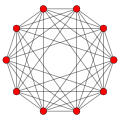Five-dimensional space
A five-dimensional space is a
Physics
Much of the early work on five-dimensional space was in an attempt to develop a
To explain why this dimension would not be directly observable, Klein suggested that the fifth dimension would be rolled up into a tiny, compact loop on the order of 10-33 centimeters.
The fifth dimension is difficult to directly observe, though the Large Hadron Collider provides an opportunity to record indirect evidence of its existence.[1] Physicists theorize that collisions of subatomic particles in turn produce new particles as a result of the collision, including a graviton that escapes from the fourth dimension, or brane, leaking off into a five-dimensional bulk.[3] M-theory would explain the weakness of gravity relative to the other fundamental forces of nature, as can be seen, for example, when using a magnet to lift a pin off a table—the magnet overcomes the gravitational pull of the entire earth with ease.[1]
Mathematical approaches were developed in the early 20th century that viewed the fifth dimension as a theoretical construct. These theories make reference to Hilbert space, a concept that postulates an infinite number of mathematical dimensions to allow for a limitless number of quantum states. Einstein, Bergmann, and Bargmann later tried to extend the four-dimensional spacetime of general relativity into an extra physical dimension to incorporate electromagnetism, though they were unsuccessful.[1] In their 1938 paper, Einstein and Bergmann were among the first to introduce the modern viewpoint that a four-dimensional theory, which coincides with Einstein–Maxwell theory at long distances, is derived from a five-dimensional theory with complete symmetry in all five dimensions. They suggested that electromagnetism resulted from a gravitational field that is “polarized” in the fifth dimension.[4]
The main novelty of Einstein and Bergmann was to seriously consider the fifth dimension as a physical entity, rather than an excuse to combine the
In 1993, the physicist Gerard 't Hooft put forward the holographic principle, which explains that the information about an extra dimension is visible as a curvature in a spacetime with one fewer dimension. For example, holograms are three-dimensional pictures placed on a two-dimensional surface, which gives the image a curvature when the observer moves. Similarly, in general relativity, the fourth dimension is manifested in observable three dimensions as the curvature path of a moving infinitesimal (test) particle. 'T Hooft has speculated that the fifth dimension is really the "spacetime fabric".[6][7]
Recent research suggests several alternative interpretations of the 5D extension of
Fifth-dimensional geometry
According to Klein's definition, "a geometry is the study of the invariant properties of a spacetime, under transformations within itself." Therefore, the geometry of the 5th dimension studies the invariant properties of such space-time, as we move within it, expressed in formal equations.
Polytopes
In five or more dimensions, only three regular polytopes exist. In five dimensions, they are:
- The 5-simplex of the simplex family, {3,3,3,3}, with 6 vertices, 15 edges, 20 faces (each an equilateral triangle), 15 cells (each a regular tetrahedron), and 6 hypercells (each a 5-cell).
- The ).
- The cross polytope family, {3,3,3,4}, with 10 vertices, 40 edges, 80 faces (each a triangle), 80 cells (each a tetrahedron), and 32 hypercells (each a 5-cell).
An important uniform 5-polytope is the
| A5 | Aut(A5) | B5 | D5 | ||
|---|---|---|---|---|---|
 5-simplex {3,3,3,3} |
Stericated 5-simplex |
 5-cube {4,3,3,3} |
 5-orthoplex {3,3,3,4} |
Rectified 5-orthoplex r{3,3,3,4} |
 5-demicube h{4,3,3,3} |
Hypersphere
A
See also
References
- ^ a b c d e f g Paul Halpern (April 3, 2014). "How Many Dimensions Does the Universe Really Have". Public Broadcasting Service. Retrieved September 12, 2015.
- ^ a b Oulette, Jennifer (March 6, 2011). "Black Holes on a String in the Fifth Dimension". Discovery News. Archived from the original on November 1, 2015. Retrieved September 12, 2015.
- ^ Boyle, Alan (June 6, 2006). "Physicists probe fifth dimension". NBC news. Retrieved December 12, 2023.
- JSTOR 1968642.
- arXiv:1401.8048 [physics.hist-ph].
- ^ Decker, Adam (February 1, 2022). "What Is Spacetime Really Made Of?". Scientific American. Archived from the original on January 18, 2022. Retrieved November 5, 2023.
{{cite web}}: CS1 maint: bot: original URL status unknown (link) - ^ Oulette, Jennifer (May 18, 2015). "Spooky Quantum Action Might Hold the Universe Together". Wired. Retrieved November 5, 2023.
- ISBN 981-02-3588-7.
- .
- ISBN 9783110697803.
- ^ Sancho, Luis (October 4, 2011). Absolute Relativity: The 5th dimension (abridged). p. 442.
- ^ Steven Booth. "Hyperbolic Geometry" (PDF).
- ^ "The Lattice A5". www.math.rwth-aachen.de.
- ^ Sphere packings, lattices, and groups, by John Horton Conway, Neil James Alexander Sloane, Eiichi Bannai [1]
Further reading
- Wesson, Paul S. (1999). Space-Time-Matter, Modern Kaluza-Klein Theory. Singapore: World Scientific. ISBN 981-02-3588-7.
- Wesson, Paul S. (2006). Five-Dimensional Physics: Classical and Quantum Consequences of Kaluza-Klein Cosmology. Singapore: World Scientific. ISBN 981-256-661-9.
- ISBN 0-486-60267-2.


